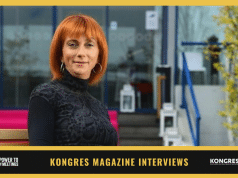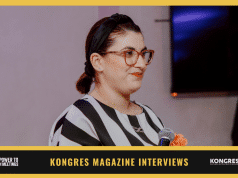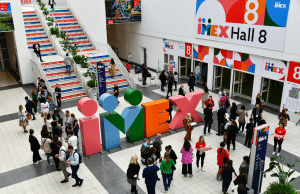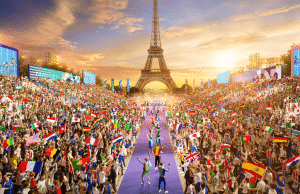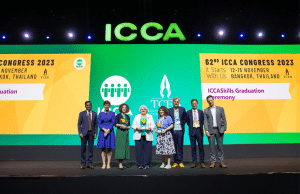Can you please introduce your position at SAP?
I am the Senior Director of global events for Europe, the Middle East and Africa + India at SAP AG and within this role I am responsible for the strategic event planning and for implementation of all regional events. This means I am responsible for the planning, event strategies and executing events, in line with our business objectives and the company’s strategy.
How many events do you organize per year?
My team is responsible for 100 to 120 events per year. The size of the events varies – from small ones for 20 people to large ones for up to 1,000, 4,000, 6,000 or even more.
Who are the clients? Who are the attendees of your events?
We are responsible for SAP events. We have work with different departments of the company – sales, marketing, project development and business development. All these are our stake holders; we define the strategy and the content of events for them. We provide services to the company, so we have different solution areas. Each has a proper marketing plan and an own event plan – my team helps them execute their events.
Can you please briefly introduce the event Sapphire you organize?
Sapphire is a flagship event of the SAP Corporation. It is an event targeting all the different audiences of the company, so it’s aimed at customers, prospects, partners, analysts, press, bloggers and even the internal audience. The event has been in existence for almost 20 years. It has always been regional – one event was held in the USA and one at a different time of the year in Europe. We also held one in the Asia-Pacific region a few years ago. It is an event that always attracts a few thousand attendees. In 2008 it was held in Berlin for around 10,000 people and in Orlando for 15,000. In 2009 we made a shift in our strategy and decided to run it only in the USA and to have a different approach. We held more local events for the near region, organizing smaller, local events for the local audiences, to bring the message of SAP to the countries, to the costumers, instead of asking them to move to the large international events.
The event evolved though the years to the concept of Sapphire now – it’s something completely new and different, still keeping the infrastructure of the previous Sapphire events but evolving into something new at the same time.
Can you explain the main differences between Sapphire and Sapphire now?
Sapphire now started with the idea of giving a different image to the company. We decided that we want to listen to our customers more. The first and the biggest change is that event takes place at the same time in Frankfurt and Orlando. So, instead of having two separate events at two separate times, we decided to have a connected event between two continents with quite a lot of elements shared between the two venues. We had shared keynotes, two broadcasting studios where we were running a kind of TV live programs that were broadcasted from one venue to the other. We also had different live streams coming from the show floor directly and seen from both venues as well as broadcasted online to sapphirenow.com. This was the mutual part of the event where we had another 30,000 people managing the content of the event. So, use of technology was really massive. The event itself was a merger of the classic traditional physical event merged with technology, social media and mutual components. This concept is really brand new. We opened discussion with our customers allowing them to directly submit the content and to become the protagonists of the event. We reduced the length of presentations from 45 minutes to 20 minutes in order to get straight to the point and give more time to one on one discussion.
Do you believe you are creating the future of events?
I wouldn’t dare to say that we are creating the future of events but I can definitely say that this is the evolution of events. I think the concept of a hybrid event where we are integrating virtual components with physical ones is definitely something that I believe will develop in the future. This year’s Sapphire now was really successful, next year’s is already being planned with the knowledge gained from this one. But definitely with Sapphire now SAP is defining a new approach to organizing events.
How will congresses, events look like in 10 years? What is the future of the meeting industry?
Technology will play a more important role. I believe virtual components will become a normal part, fully integrated into the event itself. I see social media playing a major role and becoming more and more important. So, definitely an increase in use of technology and integration of virtual parts in order to extend the length of the event pre- and post- and open it to a wider audience.
What are the basic criteria when you are choosing a destination where you will organize the next event, congress, team building?
There are three different criteria. These are: logistic, business and personal. The logistic criteria are really important, especially when considering larger events like (Sapphire now) – logistic infrastructure, hotel capacity, accessibility of the venue, transport – these are the classic logistics criteria. Business reasons analyse where we want to attract a specific market, have interest in the region or have a special reasons for bringing focus and attention to this region for business reasons. And the final criterion is the personal experience or the personal experience of someone I know. Networking is important in our small industry. The word of mouth is really important since it provides good references. All the references that I have from networking will support my decision.
Do you also organize events in Southeast Europe? What do you think about this destination?
We don’t hold large events in this region, so I don’t do a lot of business there. We are more focused on this area on a local level, since we organize events through our country representatives.. I believe that SE Europe is an attractive area from a business perspective, but I think infrastructure for big events is not there yet. I consider these countries for middle size events, for larger events I look to more mature countries.


